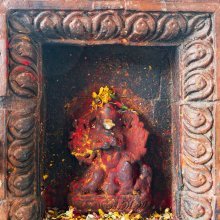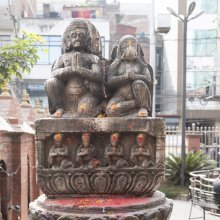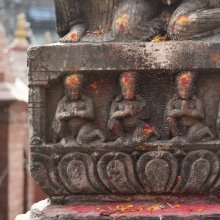Bhagavati, Bhagavatī: 17 definitions
Introduction:
Bhagavati means something in Buddhism, Pali, Hinduism, Sanskrit, the history of ancient India, Marathi, Hindi. If you want to know the exact meaning, history, etymology or English translation of this term then check out the descriptions on this page. Add your comment or reference to a book if you want to contribute to this summary article.
Images (photo gallery)
(+36 more images available)
In Hinduism
Purana and Itihasa (epic history)
Source: archive.org: Puranic EncyclopediaBhagavatī (भगवती).—The words Bhagavān and Bhagavatī mean Paramātmā (universal self) and Prakṛti (Nature and its modifications) respectively. Prakṛti is also called by the name Śakti. The following elucidation once given by Mahāviṣṇu about Bhagavān and Bhagavatī is greatly illuminating.
Time, space, atmosphere and the universe (Brahmāṇḍam) are, just like Paramātmā, eternal. This is the truth and reality. Below this eternal Gokula exists Vaikuṇṭhaloka, which also is, like the former, eternal. Just like this, Prakṛti, which is a sport to Brahmā and is also without beginning or end (Sanātanī) too is eternal. In the same manner as flame exists in fire inseparable from it, moonlight in moon, beauty in the lotus flower and brightness in the sun, so does nature exist in soul inseparable therefrom. In the same way as the goldsmith cannot make gold ornaments without gold and the potter cannot make pots without clay, the Paramātmā will not in the least be able to function unaided by Prakṛti. Prakṛti (Nature, Devī) is all powerful. 'Para' becomes powerful enough to do everything when he joins the Devī. (See full article at Story of Bhagavatī from the Puranic encyclopaedia by Vettam Mani)
Source: archive.org: Shiva Purana - English TranslationBhagavatī (भगवती) is another name for Śivā: the Goddess-counterpart of Śiva who incarnated first as Satī and then Pārvatī, according to the Śivapurāṇa 2.1.16:—“[...] the great goddess Śivā is of the three natures. Śivā became Satī and Śiva married her. At the sacrifice of her father she cast off her body which she did not take again and went back to her own region. Śivā incarnated as Pārvatī at the request of the Devas. It was after performing a severe penance that she could attain Śiva again. Śivā came to be called by various names [such as Bhagavatī,...]. These various names confer worldly pleasures and salvation according to qualities and action. The name Pārvatī is very common.
Source: Cologne Digital Sanskrit Dictionaries: The Purana IndexBhagavatī (भगवती).—Also Māyā.*
- * Brahmāṇḍa-purāṇa IV. 6. 53; 12. 42.

The Purana (पुराण, purāṇas) refers to Sanskrit literature preserving ancient India’s vast cultural history, including historical legends, religious ceremonies, various arts and sciences. The eighteen mahapuranas total over 400,000 shlokas (metrical couplets) and date to at least several centuries BCE.
Natyashastra (theatrics and dramaturgy)
Source: Wisdom Library: Nāṭya-śāstraBhagavati (भगवति, “holy lady”) refers to a specific “mode of address” (nāman) used in drama (nāṭya), according to Nāṭyaśāstra chapter 19. Bhagavati is used in addressing female ascetics and Goddesses.

Natyashastra (नाट्यशास्त्र, nāṭyaśāstra) refers to both the ancient Indian tradition (shastra) of performing arts, (natya—theatrics, drama, dance, music), as well as the name of a Sanskrit work dealing with these subjects. It also teaches the rules for composing Dramatic plays (nataka), construction and performance of Theater, and Poetic works (kavya).
Shaktism (Shakta philosophy)
Source: Google Books: Manthanabhairavatantram1) Bhagavatī (भगवती) refers to the “Supreme Goddess” as a general epithet.—Durgā and all great Kaula goddesses are ‘Bhagavatī’. ‘Bhagavatī’ is the feminine of the word ‘Bhagavat’ which is a manner of referring to the Supreme God in general but is most commonly used in the Sanskrit sources with reference to Viṣṇu. Although the goddess is represented as Viṣṇu’s Māyā in the Devīmāhātmya she is not specifically connected with him. She is called ‘Bhagavatī’ in a generic sense simply to indicate that she is the Great Goddess (Mahādevī). In North India and Nepal, Bhagavatī is particularly Durgā .
2) Bhagavatī (भगवती) refers to the “triple goddess”, according to the Manthānabhairavatantra, a vast sprawling work that belongs to a corpus of Tantric texts concerned with the worship of the goddess Kubjikā.—The Point is the Command which is threefold because of the three lineages that emerge from it. So the goddess who resides in the Yoni in the centre of the Triangle exerts her threefold authority and is called the ‘triple goddess’ (bhagavatī). Thus the Command spreads out by means of the sacred seats from where the Siddhas who founded the lineages reside. This Command is the Liṅga that arises in the centre from the Yoni. [...]
3) Bhagavatī (भगवती) refers to one of the eight Kaula consorts (dūtī-aṣṭaka) associated with Tisrapīṭha (located in the ‘end of sound’—nādānta), according to the Manthānabhairavatantra.—[...] The eight Kaula consorts (dūtyaṣṭaka): Revatī, Bhagavatī, Rāmā, Rohiṇī, Kṛttikā, Khecarī, Khaṇḍinī, Kṣānti

Shakta (शाक्त, śākta) or Shaktism (śāktism) represents a tradition of Hinduism where the Goddess (Devi) is revered and worshipped. Shakta literature includes a range of scriptures, including various Agamas and Tantras, although its roots may be traced back to the Vedas.
General definition (in Hinduism)
Source: WikiPedia: HinduismBhagavatī (भगवती): Alias Pārvatī, Shiva's wife
In Buddhism
Tibetan Buddhism (Vajrayana or tantric Buddhism)
Source: OSU Press: Cakrasamvara SamadhiBhagavatī (भगवती) refers to the “holy (goddess)”, according to the Cakrasaṃvara Samādhi [i.e., Cakrasamvara Meditation] ritual often performed in combination with the Cakrasaṃvara Samādhi, which refers to the primary pūjā and sādhanā practice of Newah Mahāyāna-Vajrayāna Buddhists in Nepal.—Accordingly, “Granting universal success, holy goddess (bhagavatī devī), homage always, Indeed with Yāminī, her holiness Mohinī, always Saṃcāriṇī, Thus with Saṃtrāsinī, the most pure, lady of yoga Caṇḍikā, Arms at four angles, her own face the palest, white Gauriṇī”.

Tibetan Buddhism includes schools such as Nyingma, Kadampa, Kagyu and Gelug. Their primary canon of literature is divided in two broad categories: The Kangyur, which consists of Buddha’s words, and the Tengyur, which includes commentaries from various sources. Esotericism and tantra techniques (vajrayāna) are collected indepently.
India history and geography
Source: Cologne Digital Sanskrit Dictionaries: Indian Epigraphical GlossaryBhagavatī.—(CII 3, 4; etc.), feminine form of Bhagavat (q. v.); often applied to goddesses, etc. Note: bhagavatī is defined in the “Indian epigraphical glossary” as it can be found on ancient inscriptions commonly written in Sanskrit, Prakrit or Dravidian languages.

The history of India traces the identification of countries, villages, towns and other regions of India, as well as mythology, zoology, royal dynasties, rulers, tribes, local festivities and traditions and regional languages. Ancient India enjoyed religious freedom and encourages the path of Dharma, a concept common to Buddhism, Hinduism, and Jainism.
Languages of India and abroad
Marathi-English dictionary
Source: DDSA: The Molesworth Marathi and English Dictionarybhagavatī (भगवती).—f (S) A name of Parvati; also for any of the principal goddesses. 2 or bhagavatīāī f A term for red chilies pounded.
Source: DDSA: The Aryabhusan school dictionary, Marathi-Englishbhagavatī (भगवती).—f A name of pārvatī, or for any of the principal goddesses. A term for red chillies pounded.
Marathi is an Indo-European language having over 70 million native speakers people in (predominantly) Maharashtra India. Marathi, like many other Indo-Aryan languages, evolved from early forms of Prakrit, which itself is a subset of Sanskrit, one of the most ancient languages of the world.
Sanskrit dictionary
Source: DDSA: The practical Sanskrit-English dictionaryBhagavatī (भगवती).—
1) Name of Durgā.
2) Of Lakṣmī.
3) Any venerable woman.
Source: Cologne Digital Sanskrit Dictionaries: Edgerton Buddhist Hybrid Sanskrit DictionaryBhagavatī (भगवती).—(1) app. name of a celestial city: Mahāvastu iii.251. 4 ff. Is Pali Bhagalavatī (Malalasekara (Dictionary of Pali Proper Names)) to be compared? (2) name of a work, a version of the Prajñāpāramitā: Śikṣāsamuccaya 188.5; 202.4; 210.3 (here citation, not quite accurate, of Śatasāhasrikā-prajñāpāramitā 1430.5 ff.); 243.15; 262.12.
--- OR ---
Bhāgavatī (भागवती).—(1) (in Sanskrit, a [female] follower of Viṣṇu, or also according to Schmidt, Nachtr., of Śiva; perhaps so here), a female follower of Viṣṇu (?): Vasumitrā nāma bhāgavatī Gaṇḍavyūha 201.11; similarly Vasumitrā bhāgavatī 201.26 ff.; (2) name of a cāturdvīpikā, q.v. (world-system of four continents; in 373.17 and 381.4—5 specifically includes a continent Jambudvīpa): Gaṇḍavyūha 373.17; 379.25; 381.4—5; 438.26.
Source: Cologne Digital Sanskrit Dictionaries: Monier-Williams Sanskrit-English Dictionary1) Bhagavatī (भगवती):—[from bhagavat > bhaj] a f. See below.
2) [from bhaj] b f. (of vat) Name of Lakṣmī, [Pañcarātra]
3) [v.s. ...] of Durgā, [ib.]
4) [v.s. ...] = ty-aṅga (below).
5) Bhāgavati (भागवति):—[=bhāga-vati] m. ([probably]) [patronymic] [from] bhaga-vat, [Saṃskārakaustubha]
6) Bhāgavatī (भागवती):—[from bhāga] f. of vata, in [compound]
[Sanskrit to German]
Sanskrit, also spelled संस्कृतम् (saṃskṛtam), is an ancient language of India commonly seen as the grandmother of the Indo-European language family (even English!). Closely allied with Prakrit and Pali, Sanskrit is more exhaustive in both grammar and terms and has the most extensive collection of literature in the world, greatly surpassing its sister-languages Greek and Latin.
Hindi dictionary
Source: DDSA: A practical Hindi-English dictionaryBhagavatī (भगवती):—(nf) a name of goddess [durgā] and [lakṣmī]; a respectable lady.
...
Kannada-English dictionary
Source: Alar: Kannada-English corpusBhagavati (ಭಗವತಿ):—
1) [noun] Pārvati, the Goddess of energy and consort of Śiva.
2) [noun] any of the Hindu goddesses.
3) [noun] a term used in respectfully addressing a reverential woman.
Kannada is a Dravidian language (as opposed to the Indo-European language family) mainly spoken in the southwestern region of India.
See also (Relevant definitions)
Starts with (+1): Bhagavati samhita, Bhagavatibhagavata, Bhagavatibhagavatapurana, Bhagavatidasa, Bhagavatigita, Bhagavatihridaya, Bhagavatike, Bhagavatikeshadipadastava, Bhagavatikilaka, Bhagavatimahatmya, Bhagavatimatapaddhati, Bhagavatipadyapushpanjali, Bhagavatiprabandhastotra, Bhagavatipujavidhi, Bhagavatipurana, Bhagavatisamhita, Bhagavatistavaraja, Bhagavatistuti, Bhagavatisutra, Bhagavatisutrasajjhaya.
Ends with: Golarthamala bhagavati, Nandabhagavati, Rakshabhagavati, Sahasrabhagavati, Subhagavati, Umabhagavati.
Full-text (+257): Bhagavant, Bhagavatimahatmya, Bhagavatisamhita, Bhagavatimatapaddhati, Sahasrabhagavati, Golarthamala bhagavati, Bhagavatistuti, Bhagavatigita, Bhagavatikeshadipadastava, Duravagrahya, Bhagavatibhagavatapurana, Bhagavatikilaka, Bhagavatipurana, Bhagavatisutra, Bhagavatipadyapushpanjali, Bhagavati samhita, Bhagavatidasa, Vasumitra, Parama-bhagavati-bhakta, Malayadesha.
Relevant text
Search found 86 books and stories containing Bhagavati, Bhagavatī, Bhāgavatī, Bhāgavati, Bhaga-vati, Bhāga-vati; (plurals include: Bhagavatis, Bhagavatīs, Bhāgavatīs, Bhāgavatis, vatis). You can also click to the full overview containing English textual excerpts. Below are direct links for the most relevant articles:
Garga Samhita (English) (by Danavir Goswami)
Verses 5.24.64-65 < [Chapter 24 - The Killing of the Kola Demon]
Verse 5.18.9 < [Chapter 18 - Uddhava Hears the Gopīs’ Words and Returns to Mathurā]
Verse 2.14.25 < [Chapter 14 - Description of Kāliya’s Story]
Jivanandana of Anandaraya Makhin (Study) (by G. D. Jayalakshmi)
Analysis of Śivabhakti < [Chapter 6 - Dramatic aspects of the Jīvanandana Nāṭaka]
Advaitic aspects of Act IV < [Chapter 5 - Advaitic principles in Jīvanandana Nāṭaka]
Advaitic aspects of Act VII < [Chapter 5 - Advaitic principles in Jīvanandana Nāṭaka]
Shat-cakra-nirupana (the six bodily centres) (by Arthur Avalon)
Dasarupaka (critical study) (by Anuru Ranjan Mishra)
Part 12 - Society in the Samudramanthana < [Chapter 6 - Samavakāra (critical study)]
Part 12 - Society in the Tripuradāha < [Chapter 4 - Ḍima (critical study)]
Part 10 - Application of the Junctures (sandhi) in a Prahasana < [Chapter 3 - Prahasana (critical study)]
Bhagavati-sutra (Viyaha-pannatti) (by K. C. Lalwani)
Related products







